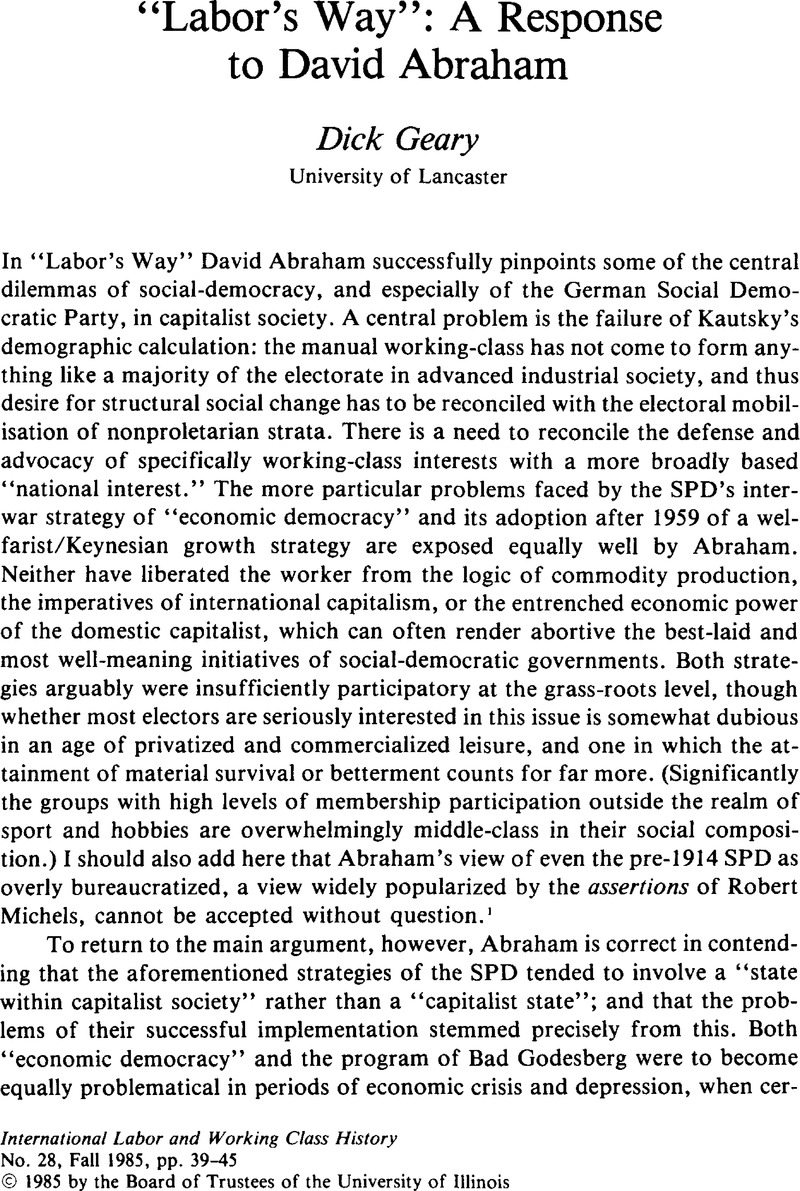Published online by Cambridge University Press: 16 December 2008

1. For a critique of Michels see Schorske, Carl E., German Social Democracy (Cambridge, Mass., 1955), ch. 5Google Scholar; Beier, GerhardGeschichte und Gewerkschaft (Cologne, 1981), 118–80Google Scholar; Breuilly, John, “The Labour Aristocracy in Britain and Germany” in Engelhardt, Ulrich ed., Handwerkerschaft und Industrialisierung in Deutschland (Stuttgart, 1984)Google Scholar; Geary, Dick“The German Labour Movement” in European Studies Review (1976), 3, 297–330CrossRefGoogle Scholar; Geary, Dick, European Labour Protest (London, 1981), 117ff.Google Scholar Much recent work has shown that local SPD branches were far from dormant or quiescent. See, for example, Nolan, MarySocial Democracy and Society (Cambridge, 1981)CrossRefGoogle Scholar on Düsseldorf Boll, Friedhelm, Massenbewegungen in Niedersachsen (Bonn, 1981)Google Scholar for Brunswick Tenfelde, Klaus, Proletarische Provinz (Munich, 1983)Google Scholar, for Penzberg. Nor was the SPD “diluted” in its class composition before 1914, despite the arguments of the revisionists and the South Germans. Approximately 90 percent of the party members were manual workers in 1914, overwhelmingly concentrated in the large towns of Protestant Germany. That is precisely why pleas for a peasant program and revisionist arguments were thrown out at conference after conference.
2. Abraham, David, The Collapse of the Weimar Republic (Princeton, 1981).Google Scholar
3. For a summary of the debate see Geary, Dick “The Industrial Elite and the Nazis” in Stachura, Peter D., ed., The Nazi Machtergreifung (London, 1983), 85–100.Google Scholar
4. See the cases collected in archives 15/140 and 15/142 in the Bergbauarchiv (Bochum).
5. RFB Gauführung Essen Faschismus im Ruhrgebiet (Essen, 1927), 8f.Google Scholar
6. See the figures in Bry, Gerhard, Wages in Germany (Princeton, 1960), 48.Google Scholar In Petzina, Dietmar, Die deutsche Wirtschaft in der Zwischenkriegszeit (Wiesbaden, 1977)Google Scholar hourly real wages in 1932 were only 75 percent of those in 1929, weekly real wages in 1932 only 85 percent of 1929. In Petzina, D. et al., Sozialgeschichtliches Arbeitsbuch, III, Munich, 1978), 98Google Scholar, the series for average weekly real wages is given as follows (1928 = 100): 1913–14, 93; 1925, 81; 1927, 89; 1928, 100; 1929, 102; 1930, 97; 1931, 94; 1932, 86.
7. Brady, Robert A.The Rationalization Movement in Germany (Berkeley, 1933)Google Scholar; Schock, Eva CorneliaArbeitslosigkeit und Rationalisierung (Frankfurt, 1977)Google Scholar; Stollberg, GunnarDie Rationalisierungsdebatte (Frankfurt, 1981).Google Scholar
8. Geary, Dick“Jugend, Arbeitslosigkeit und politischer Radikalismus am Ende der Weimarer Republik” in Gewerkschaftliche Monatshefte (05, 1983), 304–09Google Scholar; and Geary, , “Unemployment and Working Class Solidarity”, forthcoming in Evans, Richard J.Geary, Dick, eds., The German Unemployed (London, 1986).Google Scholar
9. Geary, Dick, “Radicalism and the German Worker” in Evans, Richard J., ed., Politics and Society in Wilhelmine Germany (London, 1978), 267–86Google Scholar; ibid., “Rhein, Ruhr und Revolution” in Mitteilungsblatt des Instituts zur Geschichte der Arbeiterbewegung (Bochum, 1984), 7, 30–36.Google Scholar
10. Schneider, MichaelUnternehmer und Demokratie (Bonn, 1975), 37–42Google Scholar; Feldman, Gerald D., Iron and Steel in the German Inflation (Princeton, 1977), 319–45.Google Scholar
11. Abraham stresses Silverberg's willingness to cooperate, yet real caution needs to be exercised here. See Schneider, 55–59; Weisbrod, BerndSchwerindustrie in der Krise (Wuppertal, 1978), 246–72.Google ScholarNeebe, ReinhardGrossindustrie, Staat und NSDAP (Göttingen, 1981)Google Scholar, sees Silverberg's career as that of an opportunist, who could make qualified advances to the unions in 1926 and to the Nazis six years later.
12. Schneider, 55–59;
13. Weisbrod, Schwerindustrie
14. Most accounts of Nazi Party memberships (see, for example Kater, MichaelThe Nazi Party [Oxford, 1983])Google Scholar stress the overrepresentation of artisanal interests. The same seems to apply to Nazi voting nationally (Childers, TomThe Nazi Voter [Chapel Hill, 1983])Google Scholar and at a local level, as in Franconia: see Eiber, LudwigArbeiter unter NS-Herrschaft (Munich, 1979), 13, 21, 58ff.Google Scholar
15. Weisbrod, Schwerindustrie, ch. 3
16. Ibid.
17. This is the central thesis of Schneider, Unternehmer.